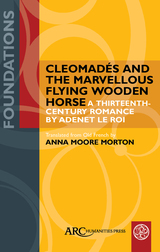154 scholarly books by Diaphanes and 15
have author last names that start with M
154 scholarly books by Diaphanes and 15
154 scholarly books by Diaphanes
15 have author last names that start with M have author last names that start with M
15 have author last names that start with M have author last names that start with M
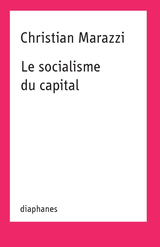
Le socialisme du capital
Christian Marazzi
Diaphanes, 2017
Depuis l'effondrement des banques en 2008, le capitalisme semble être entré dans une phase de stagnation durable, mais aussi dans une instabilité géopolitique et monétaire. Le scénario qui se joue sous nos yeux évoque une sorte de « socialisme du capital » : l’État, qui subvient aux besoins des « soviets de la finance », impose à la société la dictature du marché. Plutôt qu’un effet parasite du capitalisme, cette financiarisation pourrait bien constituer la forme aussi essentielle que perverse de son nouveau régime.
Les textes rassemblés dans le présent recueil analysent et commentent les changements économiques survenus ces dix dernières années en revenant sur leurs acteurs principaux, sur certains symptômes de la crise ainsi que sur des phénomènes qui ont pu apparaître jusque-là comme marginaux. Loin d’adopter une approche simplificatrice ou moralisante, Christian Marazzi relit les enseignements de Michel Foucault sur la biopolitique pour tenter d’interpréter les bouleversements contemporains comme des transformations fondamentales du politique.
Les textes rassemblés dans le présent recueil analysent et commentent les changements économiques survenus ces dix dernières années en revenant sur leurs acteurs principaux, sur certains symptômes de la crise ainsi que sur des phénomènes qui ont pu apparaître jusque-là comme marginaux. Loin d’adopter une approche simplificatrice ou moralisante, Christian Marazzi relit les enseignements de Michel Foucault sur la biopolitique pour tenter d’interpréter les bouleversements contemporains comme des transformations fondamentales du politique.
[more]
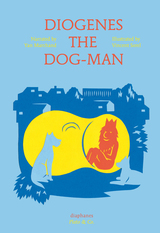
Diogenes the Dog-Man
Yan Marchand
Diaphanes, 2017
At its most basic, philosophy is about learning how to think about the world around us. It should come as no surprise, then, that children make excellent philosophers! Naturally inquisitive, pint-size scholars need little prompting before being willing to consider life’s “big questions,” however strange or impractical. Plato & Co. introduces children—and curious grown-ups—to the lives and work of famous philosophers, from Socrates to Descartes, Einstein, Marx, and Wittgenstein. Each book in the series features an engaging—and often funny—story that presents basic tenets of philosophical thought alongside vibrant color illustrations.
In Diogenes the Dog-Man, the philosopher Diogenes not only admires the honesty of dogs, he has actually become one—sleeping, eating, and lifting his leg to pee wherever he chooses! Best of all, unlike humans, who dupe one another as to their true feelings, Diogenes the Dog-Man is free to bark his displeasure and even bite his adversaries in the calves—even if they happen to be Alexander the Great. Initially, the citizens gathered in the Agora think Diogenes is mad. Does he have rabies? But it soon becomes clear that we can all learn a thing or two from dogs about how to live a simple life.
In Diogenes the Dog-Man, the philosopher Diogenes not only admires the honesty of dogs, he has actually become one—sleeping, eating, and lifting his leg to pee wherever he chooses! Best of all, unlike humans, who dupe one another as to their true feelings, Diogenes the Dog-Man is free to bark his displeasure and even bite his adversaries in the calves—even if they happen to be Alexander the Great. Initially, the citizens gathered in the Agora think Diogenes is mad. Does he have rabies? But it soon becomes clear that we can all learn a thing or two from dogs about how to live a simple life.
[more]
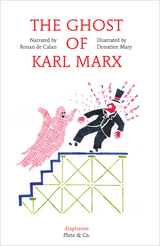
The Ghost of Karl Marx
Donatien Mary
Diaphanes, 2015
At its most basic, philosophy is about learning how to think about the world around us. It should come as no surprise, then, that children make excellent philosophers! Naturally inquisitive, pint-size scholars need little prompting before being willing to consider life’s “big questions,” however strange or impractical. Plato & Co. introduces children—and curious grown-ups—to the lives and work of famous philosophers, from Descartes to Socrates, Einstein, Marx, and Wittgenstein. Each book in the series features an engaging—and often funny—story that presents basic tenets of philosophical thought alongside vibrant color illustrations.
In The Ghost of Karl Marx, the philosopher is saddened when the town weavers must sell their cloth cheaply to compete with machines. The farmers too cannot sell their crops and have no money to buy new seeds. Forced to leave their work, the townspeople form an angry crowd in front of the factories, but what is to be done when there are so many hungry people and so few jobs to pay for food to eat? Concealed in one of the weavers’ sheets, the philosopher makes a solemn vow to give this story a happy ending by finding the Market, that infernal magician, and ridding the town of him once and for all.
Plato & Co.’s clear approach and charming illustrations make this series the perfect addition to any little library.
In The Ghost of Karl Marx, the philosopher is saddened when the town weavers must sell their cloth cheaply to compete with machines. The farmers too cannot sell their crops and have no money to buy new seeds. Forced to leave their work, the townspeople form an angry crowd in front of the factories, but what is to be done when there are so many hungry people and so few jobs to pay for food to eat? Concealed in one of the weavers’ sheets, the philosopher makes a solemn vow to give this story a happy ending by finding the Market, that infernal magician, and ridding the town of him once and for all.
Plato & Co.’s clear approach and charming illustrations make this series the perfect addition to any little library.
[more]
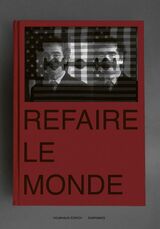
Refaire le monde
Simon Maurer
Diaphanes, 2021
Staging an exhibition as choreography, as drama, as opera, as a place where reality, politics, aesthetics, art, film, and music can address the issues of our day through documentaries, dialogues, science, activism, and creativity: This is the dream, the idea, and the mission of the “refaire le monde” exhibition trilogy at Helmhaus Zürich.
The exhibition involves some eighty different authorial voices, bringing diverse attitudes and actions into the safe space of the museum. This book is both a documentation of these new values and new worlds and a guide to them. It is people-focused, positing the arts as the model for a new human reality. Refaire le monde features many artists, including: Ursula Biemann, Pascale Birchler, Corina Gamma, Vincent Glanzmann, Fabrice Gygi, A. C. Kupper, Asia Andrzejka Merlin, Gianni Motti, Tanja Roscic, Heidi Specogna, Bertold Stallmach, and many more, as well as all those who participated in various parallel events.
The exhibition involves some eighty different authorial voices, bringing diverse attitudes and actions into the safe space of the museum. This book is both a documentation of these new values and new worlds and a guide to them. It is people-focused, positing the arts as the model for a new human reality. Refaire le monde features many artists, including: Ursula Biemann, Pascale Birchler, Corina Gamma, Vincent Glanzmann, Fabrice Gygi, A. C. Kupper, Asia Andrzejka Merlin, Gianni Motti, Tanja Roscic, Heidi Specogna, Bertold Stallmach, and many more, as well as all those who participated in various parallel events.
[more]
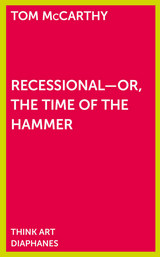
Recessional - Or, the Time of the Hammer
Tom McCarthy
Diaphanes, 2016
Modernist and contemporary literature are marked by a preoccupation with time, specifically with the passage of time characterized by starts and stops and suspended states of waiting. Acclaimed novelist Tom McCarthy brings out a temporal pattern, a subliminal convention of a certain fringe of modernism that works both in and against the canon of modernist literature in works by Thomas Pynchon, J. G. Ballard, Maurice Blanchot, Thomas Mann, Joseph Conrad, James Joyce, and William Faulkner, as well as in McCarthy’s own fiction.
The latest edition in Diaphanes’s THINK ART series, which explores the cultural and theoretical impact of artistic processes, Recessional—Or, the Time of the Hammer opens with an essay by McCarthy on recessional time as an aesthetic element and literary device. This essay is followed by an interview with McCarthy, in which he further discusses his own writing process, taking his most recent novel, Satin Island, as the starting point and casting new light on both avant-garde and realist literature.
Praise for Remainder
“An avant-garde challenge. . . . [McCarthy is] one of the great English novelists of the past ten years.”—Zadie Smith
The latest edition in Diaphanes’s THINK ART series, which explores the cultural and theoretical impact of artistic processes, Recessional—Or, the Time of the Hammer opens with an essay by McCarthy on recessional time as an aesthetic element and literary device. This essay is followed by an interview with McCarthy, in which he further discusses his own writing process, taking his most recent novel, Satin Island, as the starting point and casting new light on both avant-garde and realist literature.
Praise for Remainder
“An avant-garde challenge. . . . [McCarthy is] one of the great English novelists of the past ten years.”—Zadie Smith
[more]
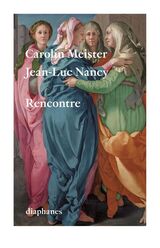
Rencontre
Carolin Meister
Diaphanes, 2021
D’une rencontre est né un dialogue au sujet de la rencontre : un étonnement partagé de la possibilité qu’ait lieu l’incalculable, l’imprévisible et l’irréductible. Une curiosité pour la justesse de ce qui n’a été ni concerté ni décidé.
Hasard, providence, intrication quantique, rituel, animisme, étreinte ou porosité, pensée ou art sont autant de tentatives de tourner autour de ce qui nous échappe quand nous nous rencontrons. Et autant de façons de se rencontrer là où la philosophie reconnait que l’art lui échappe.
Hasard, providence, intrication quantique, rituel, animisme, étreinte ou porosité, pensée ou art sont autant de tentatives de tourner autour de ce qui nous échappe quand nous nous rencontrons. Et autant de façons de se rencontrer là où la philosophie reconnait que l’art lui échappe.
[more]
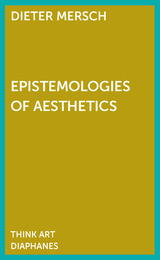
Epistemologies of Aesthetics
Dieter Mersch
Diaphanes, 2015
The ideas of “art as research” and ”research as art” have risen over the past two decades as important critical focuses for the philosophy of media, aesthetics, and art. Of particular interest is how the methodologies of art and science might be merged to create a better conceptual understanding of art-based research.
In Epistemologies of Aesthetics, Dieter Mersch deconstructs and displaces the terminology that typically accompanies the question of the relationship between art and scientific truth. Identifying artistic practices as modes of thought that do not make use of language in a way that can easily be translated into scientific discourse, Mersch advocate for an aesthetic mode of thought beyond the “linguistic turn,” a way of thinking that cannot be substituted by any other disciplinary system. A sophisticated reflection on the epistemological status of the aesthetic by one of Germany’s leading philosophers, Epistemologies of Aesthetics will be of great interest within this growing field of study.
In Epistemologies of Aesthetics, Dieter Mersch deconstructs and displaces the terminology that typically accompanies the question of the relationship between art and scientific truth. Identifying artistic practices as modes of thought that do not make use of language in a way that can easily be translated into scientific discourse, Mersch advocate for an aesthetic mode of thought beyond the “linguistic turn,” a way of thinking that cannot be substituted by any other disciplinary system. A sophisticated reflection on the epistemological status of the aesthetic by one of Germany’s leading philosophers, Epistemologies of Aesthetics will be of great interest within this growing field of study.
[more]
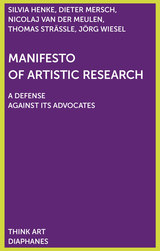
Manifesto of Artistic Research
Dieter Mersch
Diaphanes, 2020
Since its beginnings in the 1990s, artistic research has become established as a new format in the areas of educational and institutional policy, aesthetics, and art theory. It has now diffused into almost all artistic fields, from installation to experimental formats to contemporary music, literature, dance, or performance art. But from its beginnings—under labels like “art and science” or “scienceart” or “artscience” that mention both disciplines in one breath—it has been in competition with academic research, without its own concept of research having been adequately clarified. This manifesto attempts to resolve the problem and to defend the term. Further, this manifesto defends the radical potential of artistic research against those who toy all too carefully with university formats, wishing to ally their work with scientific principles. Its aim is to emphasize the autonomy and particular intellectuality of artistic research, without seeking to justify its legitimacy or adopt alien standards.
[more]
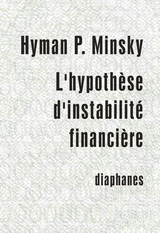
L'hypothèse d'instabilité financière
Les processus capitalistes et le comportement de l'économie
Hyman P. Minsky
Diaphanes, 2013
Comment expliquer et prévoir l’instabilité qui caractérise le développement des systèmes économiques ? Comment appréhender les « marchés sauvages » qui constituent notre réalité actuelle ? Dès les années 1960, Hyman Minsky développe une théorie consacrée à l’instabilité des systèmes. Il démontre que le krach financier est un phénomène intervenant régulièrement, qui n’est dû ni à des causes externes, ni à des erreurs d’appréciation : C’est la logique des marchés financiers elle-même, bien plus que des secousses issues de la périphérie du système, qui serait à l’origine des crises. En présentant le texte central de la théorie économique d’Hyman P. Minsky, L’hypothèse d’instabilité financière offre au lecteur une première approche passionnante de cette œuvre dense, fondamentale et jusqu’à présent méconnue en France.
[more]
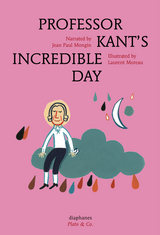
Professor Kant's Incredible Day
Jean Paul Mongin
Diaphanes, 2016
At its most basic, philosophy is about learning how to think about the world around us. It should come as no surprise, then, that children make excellent philosophers! Naturally inquisitive, pint-size scholars need little prompting before being willing to consider life’s “big questions,” however strange or impractical. Plato & Co. introduces children—and curious grown-ups—to the lives and work of famous philosophers, from Descartes to Socrates, Einstein, Marx, and Wittgenstein. Each book in the series features an engaging—and often funny—story that presents basic tenets of philosophical thought alongside vibrant color illustrations.
In Professor Kant’s Incredible Day, the philosopher Immanuel Kant wants only to be left in peace to consider life’s big questions: What can I know? What can I hope for? But, when a perfumed letter arrives one day, it interrupts his studies and sets off a series of events the dour professor could not possibly have predicted. But just when it seems as though all of Königsberg is plunged into chaos, he realizes that this perfect storm may hold the answers to his most pressing questions.
Plato & Co.’s clear approach and charming illustrations make this series the perfect addition to any little library.
[more]
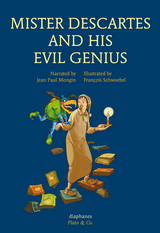
Mister Descartes and His Evil Genius
Jean Paul Mongin
Diaphanes, 2016
At its most basic, philosophy is about learning how to think about the world around us. It should come as no surprise, then, that children make excellent philosophers! Plato & Co. introduces children—and curious grown-ups—to the lives and work of famous philosophers, from Socrates to Descartes, Einstein, Marx, and Wittgenstein. Each book in the series features an engaging—and often funny—story that presents basic tenets of philosophical thought alongside vibrant color illustrations.
On a peaceful winter night while the rest of the town sleeps, Mister Descartes stays up late reading the great books of the world. Suddenly, by the light of the moon, he sees a strange and fearsome shape in the shadow of his pet parrot, Baruch. Is it an illusion, or could it be that his faithful pet is but a figment of his imagination? Could the same be true of his room and all of sleepy Holland? Quite obviously, he cannot rely on his senses, so how can Mister Descartes arrive at any certainty about the world around him? How will he determine what is a clever trick and what is real?
Plato & Co.’s clear approach and charming illustrations make this series the perfect addition to any little library.
On a peaceful winter night while the rest of the town sleeps, Mister Descartes stays up late reading the great books of the world. Suddenly, by the light of the moon, he sees a strange and fearsome shape in the shadow of his pet parrot, Baruch. Is it an illusion, or could it be that his faithful pet is but a figment of his imagination? Could the same be true of his room and all of sleepy Holland? Quite obviously, he cannot rely on his senses, so how can Mister Descartes arrive at any certainty about the world around him? How will he determine what is a clever trick and what is real?
Plato & Co.’s clear approach and charming illustrations make this series the perfect addition to any little library.
[more]
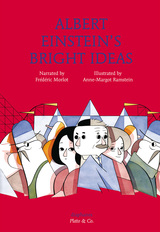
Albert Einstein's Bright Ideas
Frédéric Morlot
Diaphanes, 2017
At its most basic, philosophy is about learning how to think about the world around us. It should come as no surprise, then, that children make excellent philosophers! Naturally inquisitive, pint-size scholars need little prompting before being willing to consider life’s “big questions,” however strange or impractical. Plato & Co. introduces children—and curious grown-ups—to the lives and work of famous philosophers, from Socrates to Descartes, Einstein, Marx, and Wittgenstein. Each book in the series features an engaging—and often funny—story that presents basic tenets of philosophical thought alongside vibrant color illustrations.
In Albert Einstein’s Flashes of Inspiration, the young Albert Einstein has a very important job: he must deliver electricity to the big Oktoberfest celebration in Munich. As he hurries from one merry-go-round to another, nothing seems to be going as planned. With his sister, Maja, Heinrich the dog, and Niels Bohr, a qualified dwarf-thrower, can he win a battle against the laws of the universe? The key just may lie in the question of whether a dumpling can fly faster than light?
In Albert Einstein’s Flashes of Inspiration, the young Albert Einstein has a very important job: he must deliver electricity to the big Oktoberfest celebration in Munich. As he hurries from one merry-go-round to another, nothing seems to be going as planned. With his sister, Maja, Heinrich the dog, and Niels Bohr, a qualified dwarf-thrower, can he win a battle against the laws of the universe? The key just may lie in the question of whether a dumpling can fly faster than light?
[more]
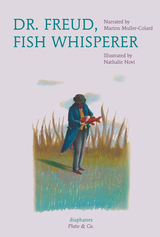
Dr. Freud, Fish Whisperer
Marion Muller-Colard
Diaphanes, 2017
At its most basic, philosophy is about learning how to think about the world around us. It should come as no surprise, then, that children make excellent philosophers! Naturally inquisitive, pint-size scholars need little prompting before being willing to consider life’s big questions, however strange or impractical. Plato & Co. introduces children—and curious grown-ups—to the lives and work of famous philosophers, from Socrates to Descartes, Einstein, Marx, and Wittgenstein. Each book in the series features an engaging—and often funny—story that presents basic tenets of philosophical thought alongside vibrant color illustrations.
Sprawled in his favorite armchair, Dr. Freud notices a peculiar phrase in pages of his notebook: “preaching to the fishes.” What could he have meant by this? If there’s one thing he has learned working as a psychoanalyst, it’s that the best way to make sense of yourself is through your dreams—and so he settles down for a nice long nap. But no sooner does his head hit the pillow than he begins to hear voices! A frightened fish with a childhood memory lodged in its throat coaxes Dr. Freud into the cold water, where his ideas come to life through an unforgettable cast of characters, including a loquacious carp and three frogs—Id, Ego, and Superego—locked in fierce competition for a single waterlily.
Sprawled in his favorite armchair, Dr. Freud notices a peculiar phrase in pages of his notebook: “preaching to the fishes.” What could he have meant by this? If there’s one thing he has learned working as a psychoanalyst, it’s that the best way to make sense of yourself is through your dreams—and so he settles down for a nice long nap. But no sooner does his head hit the pillow than he begins to hear voices! A frightened fish with a childhood memory lodged in its throat coaxes Dr. Freud into the cold water, where his ideas come to life through an unforgettable cast of characters, including a loquacious carp and three frogs—Id, Ego, and Superego—locked in fierce competition for a single waterlily.
[more]
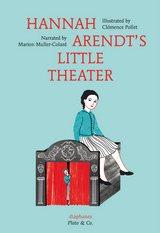
Hannah Arendt's Little Theater
Marion Muller-Colard
Diaphanes, 2016
At its most basic, philosophy is about learning how to think about the world around us. It should come as no surprise, then, that children make excellent philosophers! Plato & Co. introduces children—and curious grown-ups—to the lives and work of famous philosophers, from Socrates to Descartes, Einstein, Marx, and Wittgenstein. Each book in the series features an engaging—and often funny—story that presents basic tenets of philosophical thought alongside vibrant color illustrations.
In Hannah Arendt’s Little Theater, the philosopher Hannah Arendt is about to finish her last book, but she is sure something is missing. As she puzzles over her words, she is visited by a friend from the past—none other than her nine-year-old self! Reluctantly, she accepts young Hannah’s helping hand, joining the small blue-cardiganed girl on an adventure through the streets of New York City to a tiny theater where they watch a frightening play about a town terrorized by an evil wolf and his pack of puppets. But, even in the blackest moments, when evil seems sure to prevail, it is always possible to turn things around. Could the same be said of the “theater” of the real world, in which real people come together to create change?
Plato & Co.’s clear approach and charming illustrations make this series the perfect addition to any little library.
In Hannah Arendt’s Little Theater, the philosopher Hannah Arendt is about to finish her last book, but she is sure something is missing. As she puzzles over her words, she is visited by a friend from the past—none other than her nine-year-old self! Reluctantly, she accepts young Hannah’s helping hand, joining the small blue-cardiganed girl on an adventure through the streets of New York City to a tiny theater where they watch a frightening play about a town terrorized by an evil wolf and his pack of puppets. But, even in the blackest moments, when evil seems sure to prevail, it is always possible to turn things around. Could the same be said of the “theater” of the real world, in which real people come together to create change?
Plato & Co.’s clear approach and charming illustrations make this series the perfect addition to any little library.
[more]
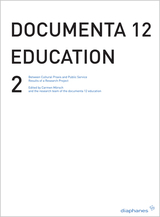
documenta 12 education 2
Between Critical Practice and Visitor Services Results of a Research Project
Carmen Mörsch
Diaphanes, 2009
»Cultural Education« is much debated. It is pivotal in sustaining a sense of community in a society that is constantly shifting. A space where differences can be explored, art exhibitions act as a superb medium for cultural and aesthetic education. They don‘t aspire to peace and harmony but to stage controversy. They enable multiple models of communication, open to dissent and rupture.
Education is situated in tension between public sphere and institution, amateur and professional, artist and audience. Its development needs felicitous examples as well as rigor in discussing problems towards identifying practical solutions.
»documenta 12 education« presents in two illustrated volumes the education formats with concomitant research, providing a basis for developing theory and praxis of gallery education.
These volumes are an ideal resource for people working in the fields of curating exhibitions, gallery education, youth work and cultural policy. People less familiar with cultural work will find in these books a valuable introduction to the field of gallery education.
Volume 2 focuses on a theory of gallery education, its methods and contexts, and reflects theoretically on examples presented in Volume 1. It is addressed to professionals from the field of gallery education, cultural education and formal education.
Education is situated in tension between public sphere and institution, amateur and professional, artist and audience. Its development needs felicitous examples as well as rigor in discussing problems towards identifying practical solutions.
»documenta 12 education« presents in two illustrated volumes the education formats with concomitant research, providing a basis for developing theory and praxis of gallery education.
These volumes are an ideal resource for people working in the fields of curating exhibitions, gallery education, youth work and cultural policy. People less familiar with cultural work will find in these books a valuable introduction to the field of gallery education.
Volume 2 focuses on a theory of gallery education, its methods and contexts, and reflects theoretically on examples presented in Volume 1. It is addressed to professionals from the field of gallery education, cultural education and formal education.
[more]
READERS
Browse our collection.
PUBLISHERS
See BiblioVault's publisher services.
STUDENT SERVICES
Files for college accessibility offices.
UChicago Accessibility Resources
home | accessibility | search | about | contact us
BiblioVault ® 2001 - 2024
The University of Chicago Press



